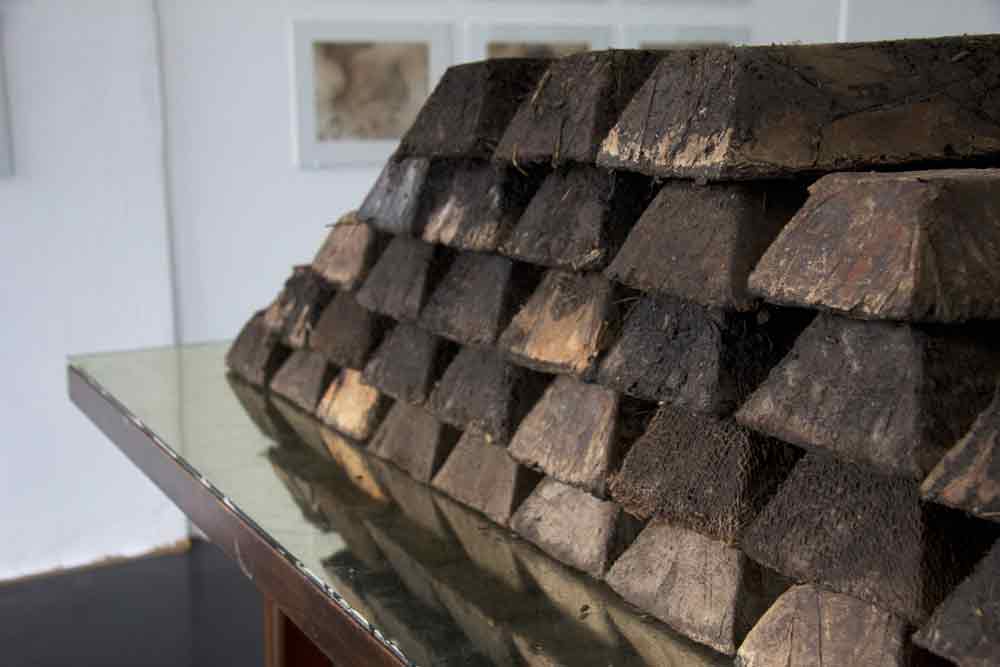777 terabytes of knowledge contained within a single gram of DNA
‘We have deprived nature of its independence, and this is fatal to its meaning. Nature’s independence is its meaning—without it there is nothing but us’28
Artist and writer Claire Pentecost suggests that we look at these seeds as material forms of collective knowledge. She states:
‘Seeds constitute the largest, longest running open source system in history, making them an essential part of the human commons. Because the seed is such a compact, portable package, it is easily commodifiable’.29
However, seeds also rely on external forces in order to grow. Anthropologist Gregory Bateson wrote:
‘Darwin proposed a theory of natural selection and evolution in which the unit of survival was either the family line or the species or subspecies or something of the sort. But today it is quite obvious that this is not the unit of survival in the real biological world. The unit of survival is organism plus environment.’30
From this perspective, soil is the other half of seeds. The equation consists of the organism plus the context in which it thrives. Soil is another part of the commons we have inherited—but it is rapidly being destroyed, eroded and depleted.
FIG. 1: Lyn, Euros. 2011. ‘Fifteen Million Merits.’ Black Mirror. Bing’s living conditions. Screenshot.
The Svabalt vault hereby serves as a metaphor: whether the seed represents the human being or the data he creates, without a fitting corresponding context, it has no way to grow, to fulfill its innate purpose. It is still useful, valuable, but there is an accompanying sense of a loss of something deeper.
‘[…] The cut-and-dried bricks with which we have constructed the present world of `material reality’ and common sense. These have always been the greatest obstacles of creative vision and of the exploration of further dimensions of consciousness and deeper realms of reality.31’
We have walked on enough concrete, smelled enough air pollution and eaten enough processed food to realize that the sort of comforts afforded us by technology in the long run differs from, and is perhaps lesser than the fragrant fruit tree filled paradise in which our ancestors dwelled.
The bleak future envisioned by Black Mirror depicts a world in which nature has fully become inaccessible to people due to the prioritization of work and consumerism. The inhabitants of this system as a result have become visibly numb. One might wonder how people could allow such a development to occur. University of Washington psychology professor Peter Kahn proposes a theory. In the early 1990s, while interviewing children from inner city Houston Texas about their environmental views and values, he identified within them a phenomenon that he coined ‘Environmental Generational Amnesia’. He proposes that people across generations psychologically experience something similar to these children:
‘All of us construct a conception of what is environmentally normal based on the natural world we encounter in our childhood. With each ensuing generation, the amount of environmental degradation increases, but each generation tends to take that degraded condition as the normal experience. This is what I have been calling “environmental generational amnesia.’32’
This theory would explain why cities continue to lose nature and why people don’t really see it happening—and how, to the extent they do, they don’t think it’s too much of a problem.
The 1970s movie Silent Running imagines this world from the perspective of one of the very last gardeners in the universe. The ecosystem that he protects is preserved within a bio-dome. As shots of the space widen, it becomes clear that it is floating in the starry expanse of outer space; in the world of Silent Running, technology is necessary to saving nature; the Earth has become ‘foul’ and uninhabitable to nonhuman life. Yet, the gardener’s crewmembers celebrate this loss.
‘Everywhere you go it’s seventy-five degrees. Everything’s the same. All the people are the same. There’s no more disease, no more poverty, [and] everyone has a job!’33
In this narrative, nature has become fully expendable. Eventually, the corporations that financially support the mission decide to destroy the nature preserves in lieu of economic gain. ‘It’s been too long. People have other things to do now.’
The danger lies in viewing nature purely by the value that it provides to us humans. Nature has become something totally at the mercy of mankind. Recently, it has been deemed valuable in the workplace, and wealthy companies have applied the changes suggested in the Terrapin study.
By assigning value to a variety of metrics influenced by biophilic design, the business case for biophilia proves that disregarding humans’ inclination towards nature is simultaneously denying potential for positive financial growth.34’
But what of the spirit? Through this lens, it appears to lose some of its simple charm. It is worth noting that spiritual practitioners traditionally have dismissed business endeavors as superficial, whereas business people see spirituality as impractical.
When examining the lives of mystics across all traditions, old and modern; they tend to be seen ‘chopping wood and carrying water’, fully engaged in the world, working, building, writing and teaching. Mystics know that the ordinary (the material) is a manifestation of the extraordinary (the spiritual) hence is aims to fully participate in both. Spirituality does not separate matter and spirit whereas business—for the most part—does.
28 Mckibben, Bill. 2006. The End of Nature. New York: Random House Trade Paperbacks.
29 Pentecost, Claire. 2015. “Soil-Erg | Claire Pentecost.” Publicamateur.Org. August 11, 2015. http://www.publicamateur.org/?p=85.
30 Bateson, Gregory, and Mary Catherine Bateson. 2000. Steps to an Ecology of Mind. Chicago: University Of Chicago Press.
31 Anagarika Govinda. 1992. The Way of the White Clouds. London: Rider. (page 15)
32 Matei, Adrienne. 2017. “Technology Is Changing Our Relationship with Nature as We Know It.” Quartz. Quartz. August 8, 2017. https://qz.com/1048433/technology-is-changing-our-relationship-with-nature-as-we-know-it/.
33 Trumbull, Douglas, dir. 1972. Silent Running. Universal Pictures.
34 Terrapin. 2012. “The Economics of Biophilia.” Terrapin Bright Green.

